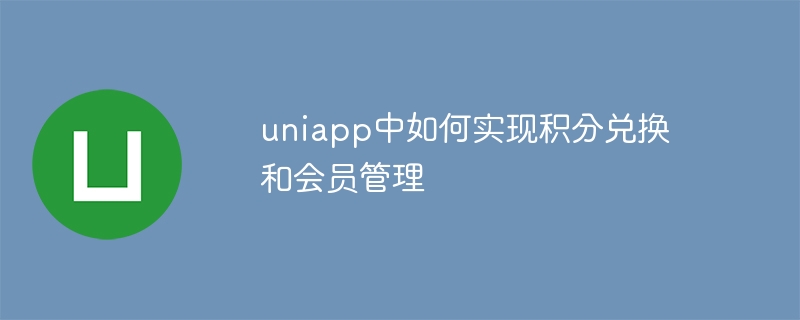Home >Web Front-end >uni-app >How to implement points redemption and member management in uniapp
How to implement points redemption and member management in uniapp
- WBOYWBOYWBOYWBOYWBOYWBOYWBOYWBOYWBOYWBOYWBOYWBOYWBOriginal
- 2023-10-20 11:00:531461browse

Uniapp is a cross-platform application development framework that integrates Vue.js and WeChat applet development capabilities, and can be developed and released on multiple platforms at the same time. To implement points redemption and member management functions in Uniapp, you can implement the following steps.
1. Design the data structure
- Define the membership table and points table, including fields such as member name, mobile phone number, level, number of points, etc. Data can be stored using cloud databases or local storage.
2. Implement the points redemption function
- Create a points redemption page in Uniapp, including the points quantity input box, product list, confirmation redemption button and other UI elements. The user enters the number of points to be redeemed, a list of redeemable products is displayed, and a button to confirm the redemption is provided.
- Use the API or third-party library provided by Uniapp to realize the rendering and redemption functions of the product list. According to the number of points entered by the user, the corresponding product list is queried and the list is displayed on the page. After the user selects the product, click the Confirm Redemption button to trigger the redemption operation.
- The redemption operation can be implemented by sending a request to the backend server, or calling the backend interface. After receiving the request, the backend server will deduct points and deliver goods based on the user's number of points and the selected product. And return the exchange success or failure information to the front end.
3. Implement the member management function
- Create a member management page in Uniapp, including member list display, adding members, editing members, deleting members and other functions.
- Through the API or third-party library provided by Uniapp, functions such as member list display, member addition, and member editing are realized. Get the member list data from the database or local storage and display the data on the page. Users can click the Add Member button to pop up a form to add members, and add members by filling in the form information. Users can click the edit button in the member list to pop up a form for editing members, and can modify member information. Users can click the delete button in the member list to delete member information.
- To implement the three functions of adding members, editing members, and deleting members, you need to send requests to the back-end server, or call the back-end interface. After receiving the request, the backend server performs corresponding operations based on the request type and data. For example, when adding a member, insert member information into the database; when editing a member, update the member information; when deleting a member, delete the member information from the database. The back-end server returns information about the success or failure of the operation to the front-end.
4. Code Example
The following is a simplified version of the code example, for reference only:
- ## Points redemption page code:
<template> <view> <input v-model="points" type="number" placeholder="请输入积分数量" /> <button @click="exchange">确认兑换</button> <ul> <li v-for="item in goods" :key="item.id">{{item.name}}</li> </ul> </view> </template> <script> export default { data() { return { points: 0, goods: [] } }, methods: { exchange() { // 发送请求到后端,并处理兑换逻辑 } }, mounted() { // 发送请求获取商品列表,并赋值给 this.goods } } </script> - Member management page code:
<template> <view> <input v-model="member.name" type="text" placeholder="请输入会员姓名" /> <input v-model="member.phone" type="tel" placeholder="请输入手机号" /> <button @click="addMember">添加会员</button> <ul> <li v-for="item in members" :key="item.id">{{item.name}}, {{item.phone}}</li> </ul> </view> </template> <script> export default { data() { return { member: { name: '', phone: '' }, members: [] } }, methods: { addMember() { // 发送请求到后端,并处理添加会员逻辑 } }, mounted() { // 发送请求获取会员列表,并赋值给 this.members } } </script>
The above is the detailed content of How to implement points redemption and member management in uniapp. For more information, please follow other related articles on the PHP Chinese website!

